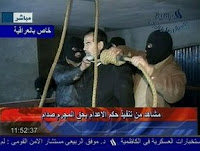 Following his execution on December 30, the remains of Saddam Husayn were turned over to the shaykh of the Albu Nasir tribe. The shaykh was moved by American military aircraft from Tikrit to Baghdad where he took custody of the body for return to Saddam's family burial plot in 'Awja, the village of his birth located about eight miles east of the city of Tikrit.
Following his execution on December 30, the remains of Saddam Husayn were turned over to the shaykh of the Albu Nasir tribe. The shaykh was moved by American military aircraft from Tikrit to Baghdad where he took custody of the body for return to Saddam's family burial plot in 'Awja, the village of his birth located about eight miles east of the city of Tikrit.A funeral service was be held at the burial site on the morning of December 31. Following that, Saddam will be laid to rest about two miles from the graves of his two sons, 'Uday and Qusay, killed by U.S. forces in a gun battle in Mosul in July 2003. The location of the sons' graves are well-known, but are not marked. To ensure that no memorials are erected by supporters, or that the bodies are not desecrated by others, the area is patrolled regularly by American troops.
The movement of Saddam's remains to 'Awja are in direct contradiction of the wishes of Saddam's eldest daughter, Raghda (age 39). She wanted the remains moved to Yemen for temporary burial until Iraq is "liberated." After she realized that was not going to be permitted, the family, acting in accordance with Saddam's last will and testament, asked that he be buried in Ar-Ramadi, a town known for its high level of insurgent activity. According to the family, Saddam had indicated that he wanted to be buried in 'Awja or Ar-Ramadi.
Why was Saddam's tribal shaykh moved by the U.S. military, why was Saddam afforded a funeral, and why were his daughter's wishes ignored?
 I suspect that prior to the signing of the execution warrant (see photo), a deal was struck between Prime Minister Al-Maliki and senior Sunni political leaders (possibly Vice President Tariq al-Hashimi, regarded as a moderate) that a funeral would be permitted and the remains would be transported to 'Awja for burial. This is unlike the treatment afforded the remains of Al-Qa'idah in Iraq leader Abu Mus'ab Az-Zarqawi who is buried in an unmarked grave in an undisclosed location.
I suspect that prior to the signing of the execution warrant (see photo), a deal was struck between Prime Minister Al-Maliki and senior Sunni political leaders (possibly Vice President Tariq al-Hashimi, regarded as a moderate) that a funeral would be permitted and the remains would be transported to 'Awja for burial. This is unlike the treatment afforded the remains of Al-Qa'idah in Iraq leader Abu Mus'ab Az-Zarqawi who is buried in an unmarked grave in an undisclosed location.A deal such as this might have been an attempt to assuage the anger and humiliation of Sunni politicians, many of whom regard the entire trial, sentencing and appeal process as rigged by the Americans and rushed to execution by the Shi'a-dominated government.

On a trivia note, the flag used to cover the coffin is the Saddam era flag. The green script between the three stars are the Arabic words allahu akbar (God is great). The two words were added by Saddam following his invasion of Kuwait in 1990 after he realized that he was facing a multinational military force intent on removing his forces from Kuwait. The addition of the Islamic phrase was an attempt to wrap his regime and actions in the mantle of Islam. On the original "Saddam flag," the words appear in script said to be Saddam's handwriting. The current Iraqi flag retains the phrase, but in a different font.
